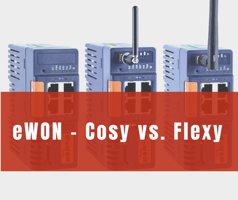New innovative technology is continuously enhancing day-to-day life. Whether it’s a virtual...
Cloud and Edge Computing: Influencing the Modern Factory
.png?width=300&name=ACD%20Image%20(8).png)
With the dawn of IIoT and the introduction of smart technology used for tracking and logging copious amounts of data and information, data access and storage are becoming an even more critical component to modern factory applications. Cloud computing and edge computing serve as the primary tools utilized by factories to access, store, and process data. Below, we’ll break down the distinctions between cloud and edge computing and discuss how they both are shaping the modern factory environment for the better.
Cloud Computing
Simply defined, cloud computing is the process by which data is stored on other computers and accessed via the Internet as opposed to being solely stored on your individual device. Now, this has obvious benefits to users, primarily in flexibility, speed, and storage. Cloud computing allows for more flexibility by giving workers the ability to access data remotely, collaborate, and instantly update work. Furthermore, cloud computing is less labor-intensive and therefore much quicker than traditional computing. This means savings in time and labor for your business. Finally, cloud computing offers almost limitless storage capacity with nominal monthly charges if you wanted to expand your capacity.
All of these advantages are directly applicable to modern factory environments. Gone are the days of being limited to the storage available on your device or not being able to work from home. Cloud computing streamlines productivity and enables your factory to consistently be functioning at a high capacity.
Edge Computing
Edge computing is “the deployment of data-handling activities and operations at the source without having to go through centralized network segments." More simply, edge computing optimizes various IoT devices, applications, etc. by bringing the computing closer to the network edge where the device communicates with the Internet. For instance, an IIoT device, such as a smart camera, will have a network edge within its processor.
But how can edge computing be beneficial for your business? In contemporary factories, edge computing is being used to elevate the power of IIoT devices. For example, by implementing edge computing into IIoT devices, large data sets can be transferred to centralized systems for immediate analysis, eliminating lag times, driving more fluid, streamlined automation.
What’s Best For Me?
Both cloud and edge computing offer distinct advantages and disadvantages. While cloud computing is primarily used to process non-time driven data, edge computing is used for the exact opposite. However, it is important to note that they are not mutually exclusive. Below is a chart detailing how cloud and edge computing can work in conjunction to benefit a business. But ultimately, it comes down to your factory’s specific needs in order to determine which option best suits you.
Application of combined cloud and edge computing in modern business applications
Image source: https://openautomationsoftware.com/blog/iiot-edge-computing-vs-cloud-computing/
Interested in learning more? Connect with an ACD expert!
You may also be interested in reading:




